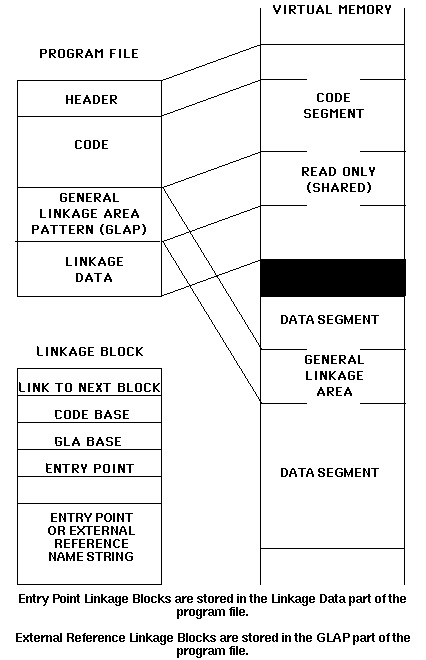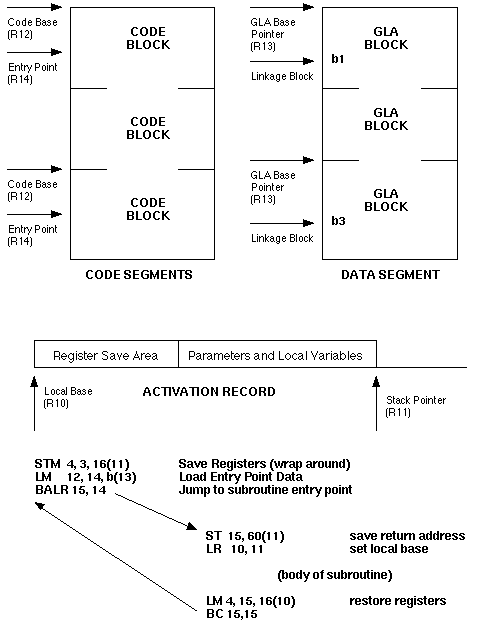External Program Linkage
A design objective of this scheme is that the code of programs should be
protected from accidental or deliberate overwriting and that code should be
shared between users whenever possible, with consequent savings of main memory
and disc space.
Program File Format and Virtual Memory Layout

The standard program file format is shown above. Program files are shareable
and while being executed are normally connected in virtual memory in read or
read-shared mode. The first four words constitute a 'file header'. This provides
the length of the file and the start of the Code area, the GLAP (General Linkage
Area Pattern) and Linkage data area, each relative to the start of the file.
The code area must be invariant so that the code can be run in read or
read-shared mode..
The GLAP contains the information needed for linking this
program file to any file it may require, including other program
files. When a program is loaded the actual program file is left
unaltered and the nececsary changes to establish external
linkage are made to a copy of the GLAP, referred to as the
GLA (General Linkage Area). This approach was suggested
by Arden, Galler, O'Brien and Westervelt (1966). Any initialised data to be used
by the program may be set up in the GLAP.
A particular program file may contain several separately
compiled routines, each of which will have a block of code and
a block of GLAP within the appropriate areas of the file.
Information required by the Program Loader is provided in
linked lists, the heads of which are stored at the front of the
linkage data area.
Linkage Data Lists
- List 1 is a list of entry points at which the program file may be
entered. These may be a main program or externally accessible
routines. The list itself is contained in the linkage data area.
Each item in the list has the format shown in the diagram above.
- List 2 is a list of external references to be satisfied by the
Loader before the program file is entered. The list items are set
up in the GLAP by the compiler which creates the file, with a
similar format to that for entry points, except that it sets the
three addresses to zero. The loader replaces the three zero-filled words with the
virtual memory addresses of the start of
the code block, the start of the GLA block and the entry point
address respectively of the program file satisfying the reference.
- List 3 is a list of external references to be satisfied dynamically
(i.e. at the time that an external routine is called). The compilers
set up items in this list in the same way as for list 2, but the
loader action is different. The three zero words are filled with
the addresses of the list item itself, an environment descriptor
for the loader (i.e. a register set and the program counter), and
the entry point address of a dynamic load sequence. If the
program uses this information to attempt to enter the external
routine it will enter the dynamic load sequence.
- A fourth list of data entry points defines initialised data areas
in the GLAP which may be referenced by other routines (e.g.
- A fifth list defines external data references to be satisfied by the loader
before the program file is entered.
When the loading process is complete the code and GLA areas
of a program are in different segments of the virtual memory.
The code is in one or more segments which are connected in
read mode, while the GLA is in a write-unshared file. The same
physical copy of the code may be in use by several other users
who have the program loaded at the same time, though not
necessarily at the same virtual memory address. It can be seen
that the shareable part of a program file must not contain any
'absolute' virtual memory addresses. With the exception of the
external references satisfied by the loader all virtual memory
addresses have to be established by the program at run-time.
External Program Calling Conventions

Before entry to an external routine, the three addresses, code
block, GLA block and entry point, inserted into the external
reference item for the called routine by the loader, are loaded
into three (consecutive) registers. One of the general purpose
registers contains the address of the start of the free space on a
common stack which all programs are constrained to use for
the entry sequence to external routines. The calling routine
may copy its registers on to the stack in the 16 words immediately ahead of the
stack free space pointer. These are restored
on return by the called routine. Any parameters to the call are
set up beyond the register save area according to standard
conventions. Control is then transferred to the entry point
address with the return address in another register. In practice
this sequence usually requires only three hardware instructions.
Dynamic Loading
In the case of a routine which is to be loaded dynamically this
entry sequence, together with the loader action defined above,
results in entry to the dynamic load sequence. This sequence
finds the program file containing the routine (if it exists), loads
it, and overwrites the relevant three words in the GLA of the
calling routine with the addresses of the code block, the GLA
block and the entry point of the called routine. Control is
transferred to the entry point. The overwriting of the three
words enables the program to use the same code sequence to
jump directly to the external routine on any subsequent call.
The actual instruction sequences used in a real implementation of this method
are given on the diagram (above) and in Appendix 1 (below).
Reference
G.E. Millard, D.J.Rees and H.Whitfield (1975). The Standard EMAS Subsystem,
The Computer Journal, Vol. 18, No. 3, pp 213-219.
Appendix 1
The use of registers in the EMAS standard subsystem external routine entry
sequence was as follows:
RO-R3 Scratch registers - not saved
R4-R14 Environment registers - saved and restored
R15 Return address
The following had special uses:
R11 Stack free space pointer
R12 Code base register
R13 GLA base register
R14 Entry Point Address register
The following were typical call and return sequences:
CALLING ROUTINE
Store parameters (if any) beyond the save area
STM 4,14,16(11) Store R4-R14 in the save area on the stack
LM 12,14,EPREF(13) Load code, GLA and Entry Point addresses of the called
routine from an entry point reference in the GLA of the
calling program.
BALR 15,14 Enter the called routine leaving the return address in R15.
CALLED ROUTINE
ST 15,60(11) It was usual to save the return address on the stack
LR base,11 Load the local base register
LM 4,15,16(base) Restore R4-R14 and pick up the return address
BR 15 Return to calling routine
This ensured that R13 had been reset to its entry value if the
called routine had changed it (which it generally had).
The called routine could set its own code base by using a BALR 12,0 instruction and
subtracting some fixed offset. However, the reset sequence was more general and
more efficient. The restoring of the registers from the save area could take
place on return to the calling routine with a LM 4,14,16(11) instruction but the
present scheme was more efficient because the called routine usually stored the
return address in memory to make R15 available for other uses, and the present
scheme reloaded R15 at negligible cost. Because we had chosen not to save R0-R3
and R15, the corresponding positions in the save area could be used for other
purposes (e.g. a dynamic or static environment chain in an ALGOL type language).
However, it is obvious that this was by no means necessary and a more general
scbeme could have used the whole save area.

harry.whitfield@ncl.ac.uk 20 March 1998 ...



